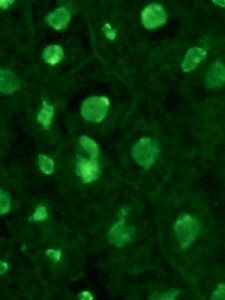ANA (Anti-nuclear antibody)
 Antinuclear antibodies (ANA) are auto-antibodies against nuclear components, including double and single stranded DNA and histones. These antibodies can be detected with an ANA test. In this technique, a fluorescent-labeled immunoglobulin is used to detect immunoglobulin in the patient's serum against nuclear components. We currently use rat liver as a source of nuclear components. Patient sample in sequential dilutions (to obtain an ANA titer) is incubated with rat liver. If there are antibodies against nuclear components, these will bind to the nuclei in the liver. The bound antibodies can then be detected using a secondary fluorescent-labeled antibody against the species-specific immunoglobulin with fluorescent microscopy. Different immunofluorescent patterns can be seen such as homogenous (shown on the left), speckled and nucleolar. However, in the dog, these patterns are not specific for a particular antibody or disease. The test requires the use of species-specific fluorescent antibody, which we only have for the dog and cat.
Antinuclear antibodies (ANA) are auto-antibodies against nuclear components, including double and single stranded DNA and histones. These antibodies can be detected with an ANA test. In this technique, a fluorescent-labeled immunoglobulin is used to detect immunoglobulin in the patient's serum against nuclear components. We currently use rat liver as a source of nuclear components. Patient sample in sequential dilutions (to obtain an ANA titer) is incubated with rat liver. If there are antibodies against nuclear components, these will bind to the nuclei in the liver. The bound antibodies can then be detected using a secondary fluorescent-labeled antibody against the species-specific immunoglobulin with fluorescent microscopy. Different immunofluorescent patterns can be seen such as homogenous (shown on the left), speckled and nucleolar. However, in the dog, these patterns are not specific for a particular antibody or disease. The test requires the use of species-specific fluorescent antibody, which we only have for the dog and cat.
The ANA test is used specifically for the diagnosis of systemic lupus erythematosis (SLE). A positive ANA titer (> 1:80) with the associated clinical signs (e.g. skin disease, polyarthritis) and laboratory findings (e.g. proteinuria, thrombocytopenia) is diagnostic for SLE. ANA tests are used to support a diagnosis of SLE, but it must be realized that positive results can be seen in a variety of conditions, other than SLE, including infectious and non-immune-mediated inflammatory disease. Some people use the ANA titer to support an immune-mediated pathogenesis in a variety of other diseases. For example, dogs with immune-mediated non-regenerative anemias often have high ANA titers (usually < 1:160), despite not having SLE.
Interpretation guidelines for canine Antinuclear Antibody Test:
The ANA test is sensitive, but not specific for SLE.
| Titer | Interpretation |
|---|---|
| Negative | A negative result argues strongly against a diagnosis of active SLE, but does not exclude the possibility of other immune-mediated disease. |
| < or equal to 1:40 | Low positive titers often are not specific for SLE (geriatric patients, various inflammatory and infectious diseases). |
| > or equal to 1:80 | High titers, if accompanied by appropriate clinical and laboratory findings, are more likely indicative of SLE. Please note that high ANA titers alone are not diagnostics for SLE. High titers can be seen in some animals with infectious or inflammatory disorders (e.g., Ehrlichiosis, Bartonellosis) and in some normal dogs. |
Interpretation guidelines for feline Antinuclear Antibody Test:
The ANA test is sensitive, but not specific for SLE.
| Titer | Interpretation |
|---|---|
| Negative | A negative result argues strongly against a diagnosis of active SLE, but does not exclude the possibility of other immune-mediated disease. |
| < or equal to 1:20 | Low positive titers often are not specific for SLE (geriatric patients, various inflammatory and infectious diseases). |
| > or equal to 1:40 | High titers, if accompanied by appropriate clinical and laboratory findings, are more likely indicative of SLE. |


